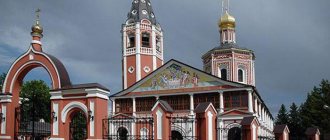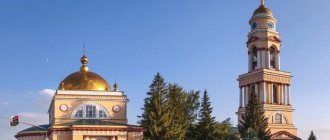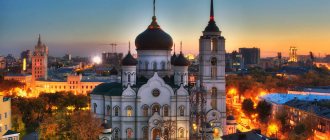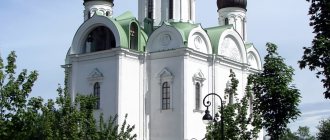Story
St. Sophia Cathedral in Polotsk is an ancient building with a difficult fate. Unfortunately, the original cathedral building, erected in the mid-eleventh century, was destroyed during the Great Northern War (a war that lasted from 1700 to 1721 between Sweden and a coalition of northern European states over the possession of the Baltic lands), and then the cathedral was rebuilt in the eighteenth century. century.
The original building was built in the image of Hagia Sophia in Constantinople. Its construction was ordered by the Prince of Polotsk Vseslav Bryachislavich, who went down in history under the nickname “Vseslav the Magician”. St. Sophia Cathedral in Polotsk became a cultural and religious center, it housed libraries, archives, the treasury, religious shrines and a princely tomb.
During the time of the Grand Duchy of Lithuania, this cathedral was the only Orthodox church in the city. In 1596, after the conclusion of the Brest Church Union, the temple was transferred to the Uniate Church. In the seventeenth century, the St. Sophia Cathedral experienced terrible fires several times, but was restored and rebuilt. During the Northern War, an ammunition warehouse was located in the cathedral, by order of Peter. According to one version, Tsar Peter demanded the keys to the “royal gates” from the servants. And when they refused, he killed the abbot and four monks in anger. After this, Peter wanted to transfer the temple to the Orthodox, but they refused, fearing revenge from the Uniates. Then it was decided to use the cathedral as a warehouse. Alas, the explosion of this warehouse became fatal for the ancient building. Today, only the masonry, foundation and frescoes remain of the original building. In the seventeenth century, the building of the Polotsk Cathedral was rebuilt, this time in the Vilnius Baroque style.
During the War of 1812, when Polotsk was occupied by the French, the cathedral building was used as stables. At the beginning of the 20th century, a major renovation was carried out in the temple. The Soviet government recognized the architectural and historical value of the St. Sophia Cathedral. Therefore, the church there was closed, but the building itself was used as a local history museum.
Even though the original ancient building of the cathedral has not survived, it amazes with its beauty and grandeur even today! The cathedral is located on the picturesque bank of the Western Dvina. Divine services are held here, excursions and organ music concerts are held. Inside the cathedral building you will find magnificent baroque columns, stucco decorations, a bas-relief image of the New Testament Trinity and even a fresco with an old copy of Leonardo da Vinci’s “Last Supper”.
Tourists most often come to Polotsk from Vitebsk. If you plan to explore all the sights of these cities, we recommend staying for a few days in any of the hotels in Vitebsk.
There are agricultural estates nearby! Look at all accommodation options in our catalog of farmsteads , cottages and recreation centers. Nature, hospitality and national cuisine!
Concerts at St. Sophia Cathedral in Polotsk
Polotsk St. Sophia Cathedral is open to visitors. Services and prayer services are regularly held here, and performances by famous organists are held in the concert hall. Concerts in the St. Sophia Cathedral in Polotsk are usually held on Sundays at 15:00.
The first concert took place in the cathedral in 1983. The listeners gathered here in the concert hall, which is known for its unique acoustic properties. In 1985, a large organ sounded in the church for the first time. Contemporary local and foreign artists are brought together in St. Sophia Cathedral every year by famous musical and cultural events.
Concert poster on the website of St. Sophia Cathedral in Polotsk
© Masha Malinovskaya
Photo
Data
There are many interesting facts associated with the St. Sophia Cathedral in Polotsk. One of them is the fact that an absolutely exact copy of the 11th century cathedral is planned to be erected on the banks of the Western Dvina River in the city of Vitebsk.
Hagia Sophia Cathedral is part of the National Historical and Cultural Museum-Reserve in Polotsk. It is also one of the country's largest cultural centers, hosting a variety of excursions and concerts.
Also in the temple building there is a functioning Museum of the Architectural History of the St. Sophia Cathedral.
Borisov stone next to the cathedral, © Masha Malinovskaya
Architectural merits of the Church of St. Sophia in Polotsk
The architectural style of the St. Sophia Cathedral in Polotsk is Vilna Baroque, also called late Belarusian. The eastern apse, foundation stones, and partly pillars have been preserved from the ancient building. Archaeologists found signatures of its builders on some of the stones.
A snow-white building with two towers, 50 meters high, looks great on the high bank of the river. Baroque introduced figured cornices, stucco molding, bas-reliefs, and sculpture, which served as decoration for the church interior.
The interior decoration is very impressive. White walls, columns, arches and elegant decor set the mood in an elevated mood with gold trim. Some of the frescoes have been preserved from previous times: these are “The Savior Not Made by Hands”, “The Last Supper” (paintings by Leonardo da Vinci were copied).
Between two faiths
A difficult fate awaited the church subsequently. She suffered from large fires several times. The government changed and the building was given a new special role. The Brest Church Union in 1596 transferred the temple to the Uniates. So, at the end of the 16th century. he became Greek Catholic, his appearance was modified. Then, during the Russian-Polish war, he switched to the Orthodox Church, and in 1667 again to the Uniates.
But not only architecture was subjected to destruction and “repression.” The Orthodox population was concerned about too much pressure from Catholic priests. This resulted in several difficult events in the 17th century. and the beginning of the 18th century. Religious strife led not only to changes of confessions, but also to bloodshed. One of these tragedies, which occurred in 1705, is associated with the name of Peter the Great.
The explosion of a gunpowder warehouse led to the destruction of the cathedral in 1710. Only in 1738-1950 did the architect Johann (Jan) Christoph Glaubitz undertake to rebuild the building. In 1812, Napoleon, like the Russian Tsar, showed no respect for the church. Within these walls he built a stable. In 1839 the cathedral again became Orthodox. Before the First World War it was updated and restored. The building turned into a museum of local history thanks to the atheistic and educational ideology of the Soviet system in the 20s of the 20th century. The Germans, who occupied these lands, used the building as a church.
Schedule of services
Divine services are not held in the cathedral itself, only on the day of memory of Euphrosyne. But there is a limit in the territory in which prayers are performed every day. The Orthodox Church is open every day. The limit schedule is as follows:
- from Monday to Friday, the doors of the temple are open from 06.30, when morning services are held, then at 05.45, from 16.30 Evening services, including midnight offices;
- on Saturday and Sunday the temple is open from 06.30 and 22.20;
- services are polyeleos, akathists to the Lord and the Most Holy Theotokos;
- Confession takes place before the Liturgy;
- every day statutory services and memorial services are held, the Undying Psalter is read;
- prayer services with akathists next to the relics of the saint.
How to get there
On the square near the station there is an information stand with various contacts and a map of the city with interesting places. Bus No. 2 departs from the train station and bus station along Oktyabrskaya Street, 25. It takes you to the Sewing Factory stop if the pilgrim is traveling from the bus station or to the District Executive Committee stop when traveling from the station located on the street. Tolstoy.
The guest can take a walk or walk and get to the architectural monument on his own. From the station you need to walk along Gogol Street to the Western Dvina embankment along the street. Nizhne-Pokrovskaya. Then turn right and walk 2 km.
Information for pilgrims and tourists
The church is located in an incredibly beautiful place on the right bank of the Western Dvina, where the Polota River flows into it. The Temple of Sophia attracts with its splendor. There are many historical and architectural monuments in Polotsk, the bulk of which belong to the Orthodox faith. The complex consists of religious buildings built at the request of Euphrosyne.
Borisov stone at St. Sophia Cathedral
The following attractions are located near the cathedral:
Borisov stone at a distance of 52 meters, this is one of 4 Belarusian boulders, on which pictures of crosses and ancient inscriptions are applied; the spring is located at the descent to Nizhne-Pokrovsky Street; a monument to a student is 468 m; Polotsk Museum of Local Lore; an art gallery half a kilometer away; a monument to heroes Patriotic War of 1812; the monument to the Krivichi people is 175 meters away; the monument to Euphrosyne of Polotsk.
Polotsk Cathedral is a historical and architectural pride; the temple is respected by all Orthodox Christians. In terms of its value, significance and veneration of believers, the church is on a par with many famous cathedrals.
Shrines and patronal feasts
Saint Euphrosyne of Polotsk went to the Lord in 1173 in Jerusalem, when she made a pilgrimage there. Her relics were buried in the monastery of St. Theodosius at the church in the name of the Most Holy Theotokos. In 1187, the Egyptians invaded the country, and the incorruptible body of the righteous woman was transferred to Kyiv.
Interior of Polotsk St. Sophia Cathedral
For 732 years, the relics of Saint Euphrosyne rested in the cave of the Kiev Pechersk Lavra. During the reign of Nicholas the First, people began to ask for the saint to be transferred to Polotsk.
The patronal day falls on August 28 - the Dormition of the Blessed Virgin Mary.











